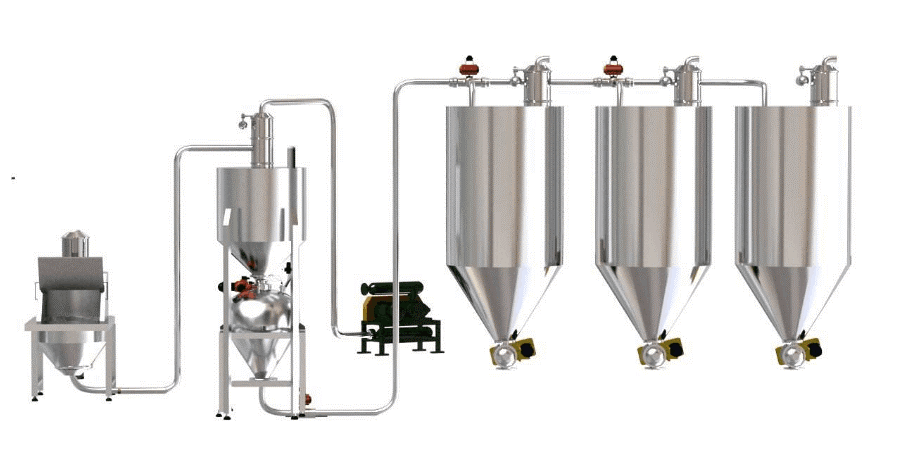Stayhungry Products
Our Products
Pneumatic conveying system
Date:2019-07-05Source:Views:

Pneumatic conveying system description:
Pneumatic conveying, also known as air conveying, is a conveying method for transporting powder and granular solid materials in a pipeline under a certain condition by using air flow as a supporting medium. The system is mainly composed of sending equipment, conveying pipeline, gas separation equipment, gas source and purification equipment and electrical instruments. The flow state of the material in the pipeline is very complicated, and varies greatly with the speed of the gas stream and the amount of material contained in the gas stream and the material properties of the material itself.
There are three types of pneumatic conveying modes for various materials and specific conveying requirements: positive pressure dilute phase conveying, suitable for medium and short-range simple and fast solutions; remote conveying in positive pressure dense phase, suitable for large conveying volume, long distance or Special material scheme; negative pressure dilute phase transportation, suitable for one-to-many, multi-to-multiple point and other automatic metering and feeding schemes in the workshop.
1. The dilute phase pneumatic conveying system uses the Roots blower as the air source, the rotary feeder is the feeding device, and a pneumatic conveying system for continuously feeding the material, which has the characteristics of low conveying pressure, high air flow speed and reliable transportation, and is suitable for Disperse and transport from one place to multiple places to dry and classify materials. The material is transported mainly by the energy held by the higher velocity airflow.
2. The dense phase pneumatic conveying system uses a pneumatic compressor as the air source and a dense phase high-pressure pneumatic conveying system for conveying materials. The system has low flow rate, low gas consumption, suitable for long distance, large capacity transportation, and ventilation. Good material, easy to achieve fluidized transportation, with low noise and less broken. Devices with such flow conditions are designed for high pressure and fluidized transport.
3. Negative pressure pneumatic transmission generally uses Roots vacuum pump as the power source, and draws the pipeline and tank warehouse into a certain vacuum state, which promotes the formation of two-phase flow of material powder and gas under the action of atmospheric pressure. The transfer line is fed into the cyclone. The two-phase flow separates most of the material from the gas in the cyclone due to centrifugal force and gravity. A small amount of material and gas enter the dust collector, and the powder is separated from the gas by the filter bag, and the gas is discharged into the atmosphere. The pressure inside the pipeline is lower than atmospheric pressure, and the feed is self-priming, but it must be discharged under negative pressure, and the distance that can be transported is short;
PreviousPipe chain conveyor system
Copyright © Wuxi Stayhungry Technology Co., Ltd. Powered By Youwei Team.
